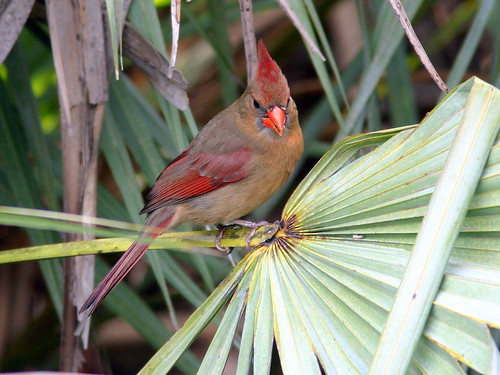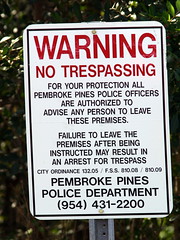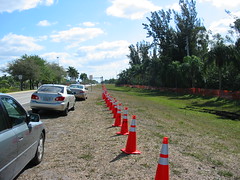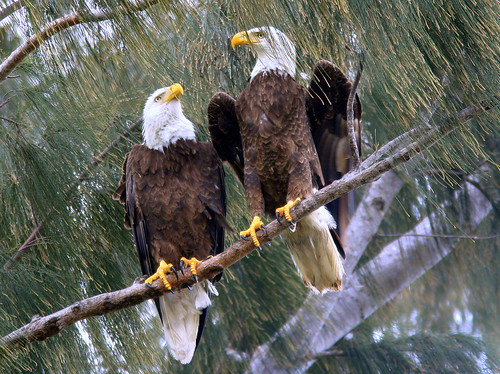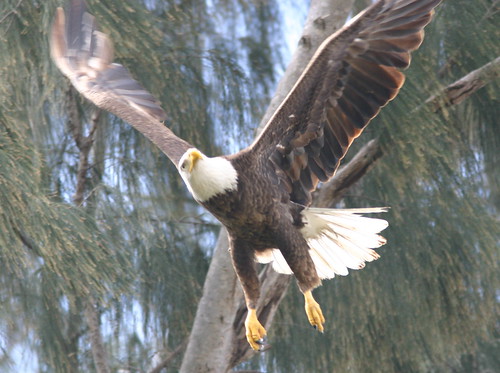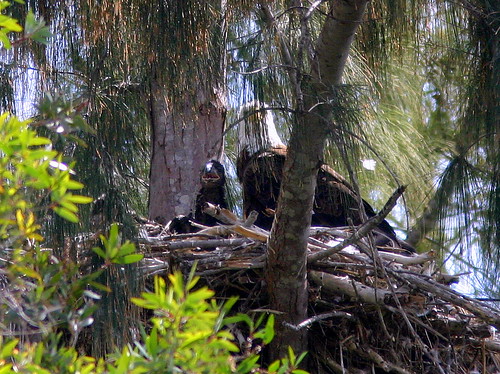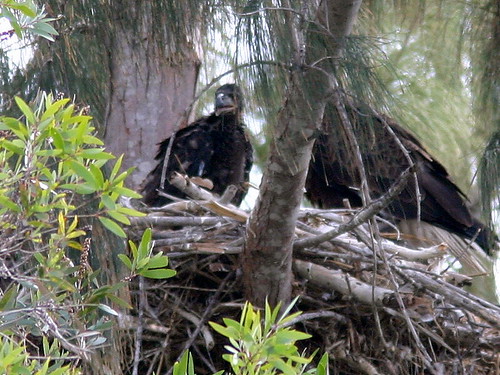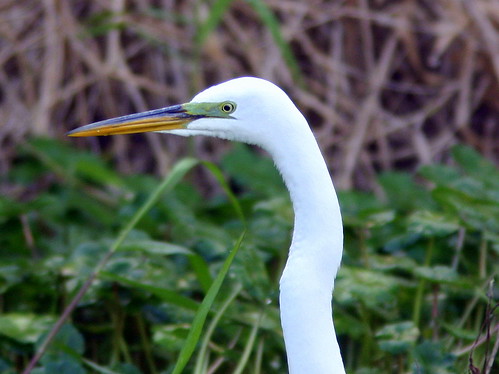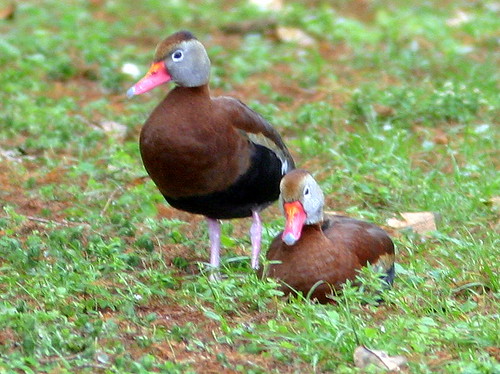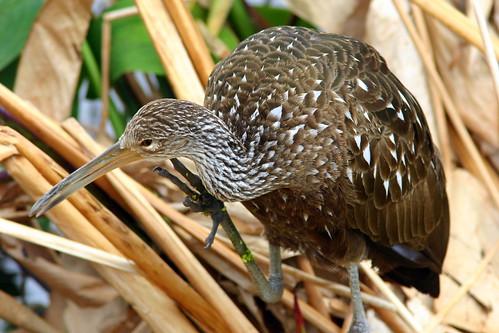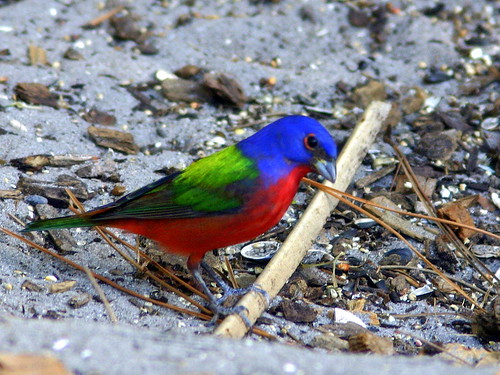Friday, February 27:
Trisha Norton, one of the Eagle Watchers, provided this reassuring
information about the eaglets. The younger one seems rather small for
its age, and it has stayed lower down in the nest for the past few
days, raising concerns about its nutritional status and welfare. It is
not unusual for an older chick to starve out its smaller sibling,
especially when food is scarce. There appears to be ample food for the
eagle.
The adults were taking turns bringing food to the nest and the eaglets
were both very active during non feeding periods as well. Both eaglets
were observed flapping their wings and moving around up towards the
nest rim. Hopefully there will be some good photos with the long lenses
to compare their development. I noticed that for a few of the feedings
the adult would bring the food to the nest and then leave quicker than
I have noticed before. The eaglets would then seem to pull and tear at
the food like the adults do. Both young were seen doing this. I don’t
know whether this means the food brought was very small or it is part
of their maturation process, or none of the above. Finally about 11:30
1 adult stood on the nest rim and the eaglets were not visible (maybe
exhausted after their busy morning feeding and excercising?) They
remained in this mode as I left at noon.“
Friday, February 27 UPDATE: Good news, which will inconvenience watchers, but better protect the eagles.The City of Pembroke Pines will now implement further protections for the “Eagle Forest.” A more permanent 6 foot metal chain link fence will be erected along the “palm line,” where the present temporary orange fence is located. Work on this phase starts very soon . This fence, donated to the City by Mitigating Circumstances, will run 1000 feet, the whole length of the block between SW 208th & 209th Avenues. I just checked with the City. They will not use mechanized equipment (e.g., air hammers) near the nest. Instead they will hand dig and use rubber mallets. The earth there is very soft and not expected to contain much rock.
A temporary orange plastic fence will also delineate the rear (south) corners of the city-owned 20 acres that make up the woodlands. The Water Management District land to the west and south, where the eagles often roost on the melaleuca trunks, will not be fenced. Signs will be placed that meet the Florida Fish and Wildlife Conservation Commission (FWC) requirements for protection of the Bald Eagle nest. Pedestrians will be prohibited on the entire south side of the block. Local police will have power to enforce (ticket) violators, an enforcement action not available directly to FWC.
Florida DOT must approve the next step, which will be to place the temporary orange fencing along the north edge of the Pines Boulevard pavement. This will eliminate parking on the shoulder, and all viewing of the nest must take place from across Pines Boulevard, on the north side of the road. The plan would be to place a 4 foot orange plastic fence, suspended between soft barriers (such as orange barrels filled with water). Don’t be alarmed when the City begins installing the fence.
On another note, I believe that Florida Power & Light (PF&L) has good reason to trim the tall Australian Pines that overhang the utility wires. Obviously, they pose a threat in the event of a hurricane. The eagles frequently use these trees as roosting sites. FP&L does not require City of Pembroke Pines approval to do such work, as they already have rights under an easement. They must be notified, that such trimming, which involves gasoline saws, creates a hazardous disturbance to the young eagles, especially during the coming weeks, when they will be climbing out on the branches of the nest tree and are prone to fall if startled.
I just learned that the City is in touch with FP&L and will attempt to assure that their tree surgeon contractor (Asplundh) is not scheduled to work at
the eagle site until around June. If they are, a delay will be sought. If other contact with FP&L is initiated, please let me know and we can close the loop and keep everyone informed. Obviously, in the meantime, if any of the Eagle Watchers see a tree trimming crew (e.g., Asplundh) begin to work, please have then call the office of Mr. Charles Dodge, Pembroke Pines City Manager, at (954) 431-4884. Such work must be delayed until late March or early April. As for FP&L, I have had wonderful cooperation and communication from the City of Pembroke Pines!
Thursday, February 26: Yesterday, many eagle watchers were alarmed because they only saw one eagle in the area all day, from 8:30 AM (when the chicks were fed and it was possible that a second, unseen adult brought in the food), until late afternoon. A reporter from NBC Channel 6 appeared on scene in the early afternoon, and several people expressed their concerns about the “missing” adult, fearing it had been injured or killed. I told the reporter that it was too early to jump to such a conclusion, as the eaglets are fed much less frequently, now that they can gobble down very large chunks of prey.
On the early evening news, the reporter voiced these concerns anyway. Then the second adult showed up and brought in prey at about 5:30 PM. I notified him and, to his credit, he clarified this in the late news show. Last month, NBC6 was the first station to contact me about the nest, just around the time that the controversy had broken out over the imminent construction right in front of the nest site. Many people were up in arms and threatened to picket the site, as it took us over a week to find out what was planned and who was doing the construction. One hundred-twenty Middle School science class students were engaged in a study of the effects of traffic on the eagles’ behavior; they and their parents worried, not only that construction would interfere with their project, but that the eagles might be harmed by construction so near to the nest..
Someone probably tipped the reporter off and had him contact me for information. I asked that the station hold off on reporting on the nest until the (then newly-hatched) eagles were fledged. He complied with my wishes, and his reward was that his station was “scooped” this past week by Channels 6 and 10, as well as by the Miami Herald and the Sun-Sentinel. NBC6 has been a friend of the Bald Eagles. Last year, the station sponsored the placement of a satellite transmitter on a fledgling in the Everglades. Unfortunately, that signal was lost in a matter of a few days.
This photo, which I took this morning, provides evidence that the two eagles are alive and well (click on photo to see larger images):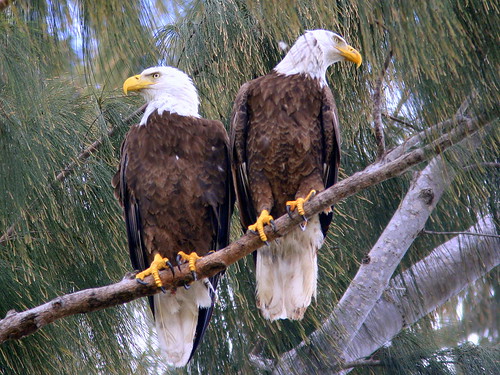
The male, on the right, as identified by his smaller size and the thinner base to his bill, pecks playfully at his mate:
She reproaches him, and, startled, he rears back:
The male has had enough, and flies off (probably because his mate told him to go look for more food ( ;>) )
Wednesday, February 25: We were away birding in Palm Beach County all day yesterday and this morning. We returned today to find that the City of Pembroke Pines had responded to our request that they put up “No Trespassing” signs at the boundary of the city property that contains the nest. The Pembroke Pines officials were alarmed at the report of a photographer, all decked out in camouflage gear and carrying a camera with very large lens, who entered the woods and approached the nest tree. Apparently a “professional,” his action alarmed the several lay people who were keeping their distance and observing the nest quietly from about 200 feet on the south side of the road. He was said to be “nasty” when one of the “non-professionals” pointed that he should not have gone so near the nest. I hate to give him any credit, but we can probably thank this creep for the City’s decision to ramp up measures to protect the nest from unusual disturbances.
The younger chick, on the far left, though hatched only 5 days after its older sibling, appears considerably smaller for its age. It probably has trouble competing for food with its bigger and stronger nest-mate:
This is the older chick, also photographed today (February 25th). It retains a last remnant of white natal down as a small skullcap:
The City is apparently in negotiations with the Florida Fish and Wildlife Conservation Commission (FWC) as well as officers of the Broward County Audubon Society, to determine what is best for the eagles and the viewing public. I have been more concerned about public safety, as the birds appear to have adapted to the crowds that now visit the nest daily.
As an important first step, the city has now posted “No Trespassing” signs along the front (north) boundary of the 20 acre woodland patch (which we call the “Eagle Forest). Additionally, a four-foot orange plastic fence now provides a physical barrier against entry into the woods, and traffic cones have been placed by the Pembroke Pines Police Department in a row about ten feet in from the edge of Pines Boulevard, forming a buffer zone about 40 feet wide in front of the posted area. These are intended as a deterrent against visitors approaching any closer to the nest, but some people think they only apply to vehicles, and must repeatedly be asked not to move past the boundary demarcated by the pylons.
More must be done about this– signs prohibiting entry into this buffer area and perhaps, an additional fence may be in order. Also under negotiation are other measures, such as prohibiting parking on the entire south side of Pines Boulevard between 208th and 209th Avenues, and limiting eagle watching to the north side of the road.. Since there is no shoulder on that side, viewers would have to park on the south side of the road east of 208th and west of 209th.This could present the problem of gawkers slowing or stopping in the traffic lanes or in the right turn lane just east of 209th, risking a rear-end collision. People may try to cross at locations without a traffic signal. At around 7:00 AM the school buses on their way to the High School queue in the turning lane, and any vehicles obstructing traffic would surely be ticketed.
The Painted Bunting is one of the most beautiful of our North American land birds. The female is a splendid green, matched only by some parrots and the Green Jay– except for splashes of green on some other birds, such as ducks, I can’t think of any others so colored. The male is ‘painted” surrealistically in bright red, blue and green. It was one of Mary Lou’s most sought-after birds. She finally got a brief look at one in Corkscrew Swamp this year.
This past Tuesday, we took a break from watching our local Bald Eagle nest (where the area around the nest has finally been temporarily fenced and posted) and spent all day birding wetlands in western Palm County. We had four “target” birds that we had seen previously, but really wanted to get better looks and perhaps photograph them: Snail Kite, Limpkin, Black-bellied Whistling-Duck, and Painted Bunting.
We started at Loxahatchee National Wildlife Refuge, worked our way west to the nearby Wakodahatchee Wetlands, in Delray Beach, and thence to Green Cay Nature Center in Boynton Beach. After checking in at a nearby motel, we had a very nice dinner with one of my old friends and his wife who were visiting Florida from their home in New York. He was my classmate all the way from Kindergarten through High School in Rutherford, New Jersey.
The next morning, before heading home we went on to Okeeheelee Nature Center in West Palm Beach. We dipped on the Snail Kite at Loxahatchee, which is usually the best place to find one. One had been roosting near the Visitor Center just the day before, but they are said to be easier to find when they begin nesting in a month or so.
However, this Great Egret at Loxahatchee, in breeding condition, displayed marvelous plumes and a green mask (click on all images to choose larger views):
Wakodahatchee yielded great views of the whistling-ducks:
The Limpkin, named for its “limping” walk, is a much sought-after southeastern US specialty bird. We found a very obliging Limpkin at Wakodahatchee:
While not rare, Limpkins are notoriously hard to find. Our previous sightings of Limpkins were always transitory, as the birds have a habit of dissolving into the reeds a few seconds after being seen. This one scratched its chin nonchalantly:
Okeeheelee is famous for the Painted Buntings that gather at the feeders near the interpretive center. We were not disappointed.
We saw three males in full plumage. Here are two:
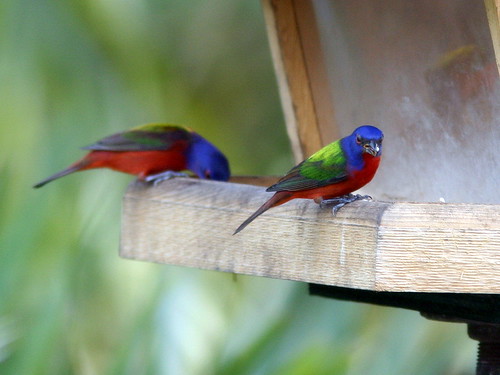
We could not get enough of them. I maxed out the camera memory card:
Another view shows a more distinct eye ring on his right side:
The green females seemed more numerous than the males, and were less timid about visiting the feeders: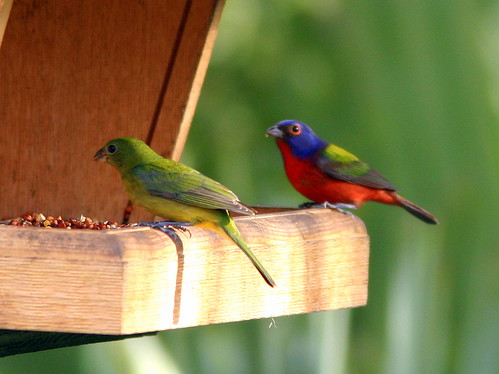
I am always thrilled at the subtle beauty of the female Northern Cardinal. This one fed with the buntings: